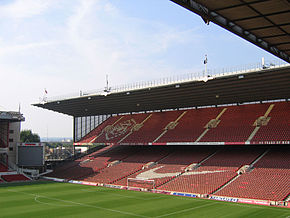Highbury Stadium
| Highbury – the "Home of Football" | |

Stadium in 2005, a year prior to demolition
|
|
| Full name | Arsenal Stadium, Highbury Stadium |
|---|---|
| Location | Highbury, London, England |
| Coordinates | 51°33′28″N 0°6′10″W / 51.55778°N 0.10278°WCoordinates: 51°33′28″N 0°6′10″W / 51.55778°N 0.10278°W |
| Owner | Arsenal Holdings plc |
| Operator | Arsenal |
| Capacity | 38,419 (at closure), 73,000 (peak) |
| Field size | 109×73 yds / 100×67 m |
| Construction | |
| Opened | 6 September 1913 |
| Renovated | 1932–1936, 1992–1993 |
| Closed | 7 May 2006 |
| Demolished | 2006; redeveloped as housing |
| Construction cost | £125,000 (1913 original) adjusted by inflation: 11092671 £175,000 (1930s redevelopment) adjusted by inflation: 9977934 £22.5m (1990s redevelopment) adjusted by inflation: 46m |
| Architect |
Archibald Leitch (1913 original) C. W. Ferrier and W. Binnie (1930s redevelopment) Populous (North Bank) |
| Tenants | |
| Arsenal F.C. (1913–2006) | |
Arsenal Stadium was a football stadium in Highbury, North London, which was the home ground of Arsenal Football Club between 6 September 1913 and 7 May 2006. It was mainly known as the "Highbury Stadium" due to its location and was given the affectionate nickname of the "Home of Football" by the club.
It was originally built in 1913 on the site of a local college's recreation ground and was significantly redeveloped twice. The first reconstruction came in the 1930s from which the Art Deco East and West Stands date. There was a second development; the first phase was completed in 1989 which added executive boxes to the Clock End, and afterward in 1993 a new North Bank Stand was constructed, both following the recommendations of the Taylor Report which replaced the terraces to make the stadium an all-seater with four stands. However, further attempts to expand the stadium were blocked by the community, and the resulting reduction in capacity and matchday revenue eventually led to Arsenal opting to build a new stadium, to become known as the Emirates Stadium in nearby Islington. After the club moved to their new stadium upon the conclusion of the 2005-06 season, Highbury was redeveloped as a residential development known as Highbury Square, with the Clock End and North Bank stands being demolished; parts of the East and West Stands remained and were incorporated into the new development due to their listed status.
The stadium also hosted international matches – both for England and in the 1948 Summer Olympics – and FA Cup semi-finals, as well as boxing, baseball and cricket matches. Its presence also led to the local London Underground station being renamed to Arsenal in 1932, making it the only station on the Underground network to be named after a football club.
...
Wikipedia
